
The Gin Craze
The cover image is Gin Lane by English artist William Hogarth issued in support of what would become the Gin Act.
The Gin act was introduced to prohibit gin distillers from selling to unlicensed merchants and increasing fees charged to merchants. This act eliminated small gin shops, particularly what were known as Gin carts, which served Gin to Londoners as they worked or did not work as the case may be.
The Gin Craze was a period in the first half of the 18th century when the consumption of Gin in the UK (notably London) had risen to the equivalent of 2 pints per week per Londoner.
Bludgeoning
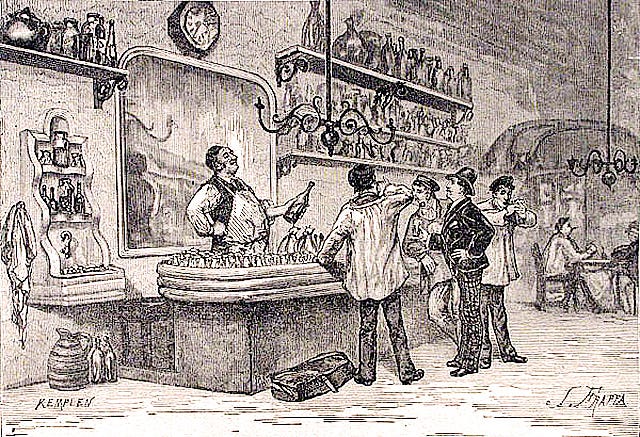
L’Assommoir (1877) is considered one of Émile Zola’s masterpieces. It is a study of alcoholism in working-class Paris. It was the focus of my college dissertation, what I focussed on was the meaning of L’Assommoir and the use of the verb assommerthroughout the book.
Assommer — to knock out to stun
Il l’a assommé avec une bouteille. He knocked him out with a bottle.
I never thought I would use what I learned again, but this seems relevant in today’s society for the same reasons ‘Gin Lane’ is.
Why all the Gin and the Bludgeoning?
When I explain to my kids that when I was a kid we used to get water from a hand pump they cannot understand it. In some ways, it seems quite ridiculous to them. In a similar way, when we think back to the Gin Craze days or indeed 18th century Paris we think it was almost barbaric.
The bludgeoning from reality happened when the world was adapting to the industrial revolution. People were adapting to an urban life and a shift from an agrarian to industrial society. These shifts made people very unhappy, to mask their miserable realities they hit the gin in London and hit the eau de vie (ironically “water of life”) in Paris.
Wine, TV, Social Media
A more sophisticated version of gin carts is a bottle of wine or a few beers at home at the end of a hard day. This is often done in front of mind-bludgeoning TV (Kardashians, Jersey Shore, Netflix), while holding a smartphone checking out social media.
We all need to switch off, we all need an outlet. The question we need to ask ourselves is why? Are we sipping on a glass (or bottle) of wine to relax or to mask? Are we watching mindless TV to relax or to forget? Are we addicted to social media?
A New Gin Act for Technology
Many parents are concerned about their children’s futures in a world of technology. We are afraid they will fall prey to addictive technologies, phones, tablets, social media. Are we simply reflecting the fear that we are becoming addicted too?
There will be no equivalent to the Gin Act for technology. It is hard to quantify the negative effects of social media and technological addition.
Thankfully, we are seeing signals in society, like in France where it is forbidden to send a work email after 5 pm. Many have mocked the French for this, but are they right?
Employees “leave the office, but they do not leave their work. They remain attached by a kind of electronic leash — like a dog.” — Benoit Hamon (French Legislator)
“S”ociety Curves
For regular readers of The Thursday Thought, you will have read about the S curve model. The S curve model can be used to gauge how quickly an innovation will be adopted by and penetrate a market. Here is a quick overview.
S curves follow the shape of the letter S with a flat start with early adopters and niche clientele. Rapid growth comes next, with a sudden peak after the flat start, finally comes a dominant position in the market.
After the rapid growth phase, businesses or products begin to plateau and experience stagnation, optimisation, automation, job cuts and quite often a me-too proposition.
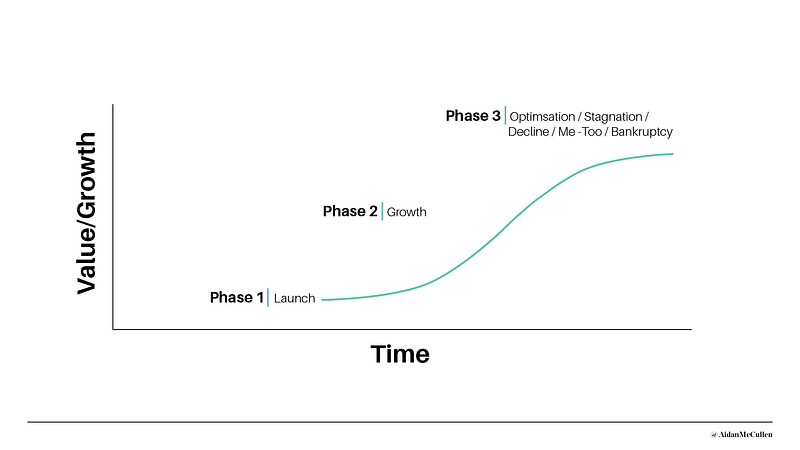
To innovate, companies and leaders need to jump from one S curve to another, but few have the courage to do so. The jump always looks like a step backwards.
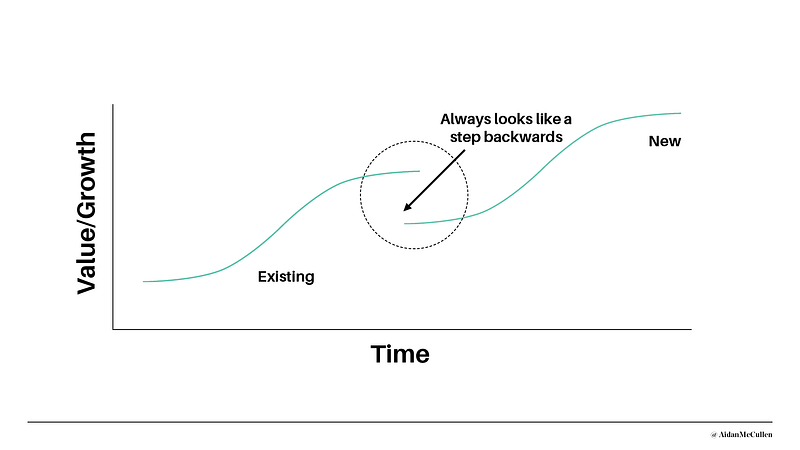
When Blockbuster CEO, Jim Keyes took over the company, he ignored the next jump for Blockbuster was a new model, not a better version of the current one. When quizzed over why he turned down the option to acquire Netflix (for under 1 million) he stated: “Neither RedBox nor Netflix are even on the radar screen in terms of competition”. Not long after Blockbuster went bankrupt and we know the success story Netflix is today.
From Keyes perspective he was doing a good job focussing on what Blockbuster did well today and felt looking at the next jump (which looks like a step back) was a distraction.
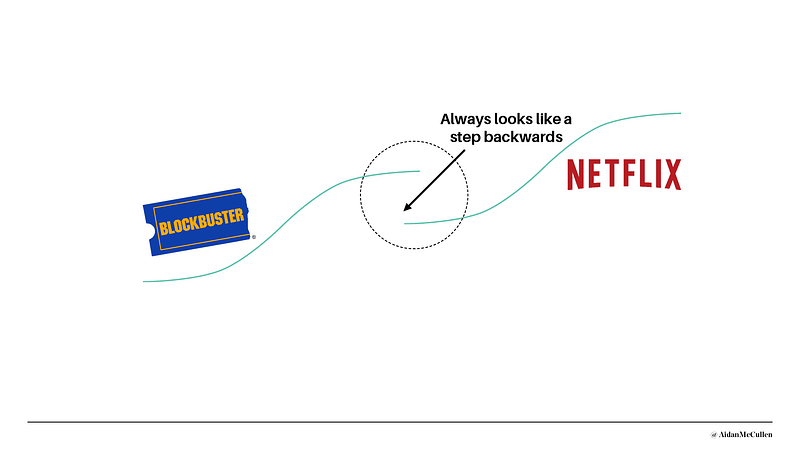
All of these occurrences happen in our society too.
“S”ociety
For a moment think of the adaptation to change in our society as an S curve. When we are at the top of the curve we are ill at ease, just like a business. The jump from one curve to another is equally uncomfortable.
Society is at a stage where more people are dying from abundance than lack. Obesity and obesity-related illnesses kill more people than starvation. People are at a point where their basic needs are more than met. We are spending more money on experiences than “stuff”. We want to understand more about ourselves and unlock our potential. We want to stand for something and make a difference in the world. In Maslow’s hierarchy of needs, we are at the point of Self-actualisation. (see below)
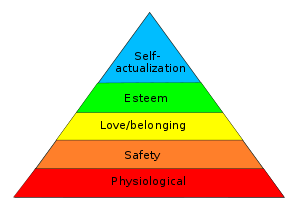
Vast changes in society have come in line with advancements in education. As a result, it is as if humanity itself is at the top of its S curve. We are at the stage of optimising people through augmented humanity and exponential improvements in health care. Genetic engineering can prevent (or reverse) the ageing of our cells. Scientists are researching how to create new human organs using 3D printers and loaded with living cells.
Is the next jump of the S curve a jump to Artificial Intelligence to a technology-led society? Are many of us simply reacting to this changing world by bludgeoning ourselves to reality?
Societal Whiplash

“When everything is moving quickly except us, the consequence is a social, cultural, and economic “whiplash.” — Joi Ito (MIT media lab)
This week’s guest on the Innovation Show is Andrew Keen, we discuss his new book ‘How to Fix The Future’. As Andrew tells us, there is no human version of Moore’s Law, “Technology doesn’t solve technological problems; people do” and this happens through governmental reform, through regulation, through lobbying, through education reform, through the prioritisation of our human traits.
“Technology doesn’t solve technological problems; people do” — Andrew Keen
Ultimately, it takes people to change the world, not technology and we have adopted a technology-will-solve-the-problem mentality. Right now, we are leaving decisions to the behemoth tech firms to make decisions, to lobby governments and to shape the next “s”ocietal jump.
We all have a choice, we can voice our concerns, we can break away from the modern-day Gin Craze. Andrew’s book encourages us by exploring how we have successfully managed such change in the past.
We have successfully managed and adapted to the shift from an agrarian society to an industrial one. We can successfully manage the change a new society we are witnessing today, but we need to be prepared and we need to change how we operate.
Many people are desperately unhappy in their jobs. As Peter Himmelman told us recently on the show: “Unengaged employees are essentially checked out. They’re sleepwalking through their workday putting time — but not energy or passion — into their work.”When this happens we find ways to mask an unhappy reality, we bludgeon ourselves from reality at night and we sleepwalk by day. When we do that, we miss the opportunity to make a difference and we let the world take shape around us, rather than play a hand in shaping the World.
These are important questions. These are questions that need to be raised. These are questions that will take time to answer, but at least they need to be addressed.
IF YOU LIKE THIS POST, PLEASE HIT LIKE SO OTHERS SEE IT
This week’s innovation show is EP 88: How To Fix The Future with Andrew Keen the pioneer of calling into question the impact of technology and new business models on society.
A must listen for governments, education, business and parents.
Andrew’s book “How to Fix the Future” outlines a map of how we might approach the future of humanity amidst a world of ai, technology, algorithm and tech behemoths.
We explore:
– Legal regulation, where innovation and regulation are symbiotic. Andrew discusses some of the exemplars of regulation and how we can learn from them
– Governments driving change such as Estonia, Singapore, India and China
– Innovators and innovations diving change
– The role of consumers and social responsibility, where consumers shape society with their needs
– Philanthropists: non-profits and committed change makers like Edward Snowden
– Education: our roles as parents, teachers and educators of every kind
Website: http://bit.ly/2FwsOJw
Soundcloud: https://lnkd.in/eX_77-U
Spotify: http://spoti.fi/2rXnAF4
iTunes: https://apple.co/2gFvFbO
Tunein: http://bit.ly/2rRwDad
iHeart Radio: http://bit.ly/2E4fhfl
Subscribe by email: http://bit.ly/2EWVlbj